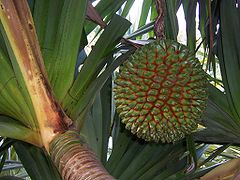
Pandanus
Did you know...
This wikipedia selection has been chosen by volunteers helping SOS Children from Wikipedia for this Wikipedia Selection for schools. With SOS Children you can choose to sponsor children in over a hundred countries
| Pandanus | |
|---|---|
 |
|
| Fruit of Pandanus utilis | |
| Scientific classification | |
| Kingdom: | Plantae |
| Division: | Magnoliophyta |
| Class: | Liliopsida |
| Order: | Pandanales |
| Family: | Pandanaceae |
| Genus: | Pandanus Parkinson |
| Species | |
|
See text |
|
Pandanus is a genus of monocots with about 600 known species. Plants vary in size from small shrubs less than 1 m tall, up to medium-sized trees 20 m tall, typically with a broad canopy and moderate growth rate. The trunk is stout, wide-branching, and ringed with many leaf scars. They commonly have many thick prop roots near the base, which provide support as the tree grows top-heavy with leaves, fruit, and branches. The leaves are strap-shaped, varying between species from 30 cm up to 2 m or more long, and from 1.5 cm up to 10 cm broad.
They are dioecious, with male and female flowers produced on different plants. The flowers of the male tree are 2-3 cm long and fragrant, surrounded by narrow, white bracts. The female tree produces flowers with round fruits that are also bract-surrounded. The fruits are globose, 10 to 20 cm in diameter, and have many prism-like sections, resembling the fruit of the pineapple. Typically, the fruit changes from green to bright orange or red as it matures. The fruit of some species are edible. Pandanus fruit are eaten by animals including bats, rats, crabs, elephants and monitor lizards, but the vast majority of species are dispersed primarily by water.
- Selected species
|
|
P. odoratissimus is used for P. fascicularis or P. tectorius.
Cultivation and uses
Pandan ( P. amaryllifolius) leaves are used in Southeast Asian cooking to add a distinct aroma to rice and curry dishes such as nasi lemak, kaya ('jam') preserves, and desserts such as pandan cake. Pandan leaf can be used as a complement to chocolate in many dishes, such as ice cream. They are known as daun pandan in Indonesian and Malay; and 斑蘭 (bān lán) in Mandarin. Fresh leaves are typically torn into strips, tied in a knot to facilitate removal, placed in the cooking liquid, then removed at the end of cooking. Dried leaves and bottled extract may be bought in some places.
"Kewra" is extract distilled from the Pandanus flower, used to flavour drinks and desserts in Indian cuisine.
Throughout Oceania almost every part of the plant is used, with various species different from those used in Southeast Asian cooking. Pandanus trees provide
- materials for housing,
- clothing and textiles including the manufacture of Dilly Bags (carrying bags), fine mats or ‘ie toga,
- food,
- medication,
- decorations,
- fishing,
- religious uses
Pandan is said to be a restorative, deodorant, indolent and phylactic, promoting a feeling of wellbeing and acting as a counter to tropical lassitude. It may be chewed as a breath sweetener or used as a preservative on foods. It is also said to have flavonoids which are believed to have a variety of healthful properties, including antiviral, anti-allergen, antiplatelet, anti-inflammatory, and antioxidant.
Cockroaches tend to dislike the smell of pandan leaves. In Asia, a car infested with cockroaches can generally be rid of the cockroaches by leaving a handful of fresh pandan leaves overnight in the vehicle.
- Vernacular names
- Chamorro: åkgak (P. tectorius), påhong (P. dubius), kafo', paingut, akå'on
- Chinese (Cantonese): Baan laahn, Chan heung laahn, Chat yihp laahn, Heung lahm tauh
- Chinese (Mandarin): 班兰 (班蘭) [bān lán], Chen xiang lan, Qi ye lan, Xiang lin tou
- Czech: Pandán
- Danish: Skruepalme
- Dhivehi (Maldivian): Kashi'keyo
- Dutch: Schroefpalm, Pandan
- English: Pandanus, Screwpine, Umbrella tree, Screw tree
- Estonian: Lõhnav pandan
- Finnish: Kairapalmu
- French: Pandanus
- German: Schraubenbaum, Schraubenpalme
- Hawaiian: Hala
- Hebrew: הפאנדאנוס, Ha-pandanus (refers to entire genus)
- Hindi: Ambemohor pat, Rampe
- Hungarian: Pandanusz levél, Panpung levél, Csavarpálma levél
- Indonesian: Pandan
- Italian: Pandano
- Japanese: Nioi-takonoki, Nioi-adan
- Kapampangan: Pandan (Pandanus amaryllifolius), Pandan Lalaqui (Pandanus utilis )
- Khmer: Taey
- Korean: Pandanusu (판다누스)
- Laotian: Tey Ban, Tey hom
- Lithuanian: Amarilinis pandanas
- Malay: Pandan Wangi
- Malayalam: Kaitha
- Marshallese: Pob
- Persian: کادی (Kādì)
- Philippines: Pandan
- Polish: Pandan, Pochutnik
- Portuguese: Pândano (Brazil), Pándano (Portugal)
- Sāmoan: Fala
- Singhalese: Rampe
- Spanish: Pandan, Pandano
- Tagalog: Pandan, Pandan mabango, Bicolano language, Kalagimi (P. simplex), Alasas (P. radicans)
- Tahitian: Fara, Hinano
- Thai: ใบเตย, เตยหอม, เตย, Panae-wo-nging, Bai Toey, Toey-hom, Toey
- Tongan: Fā (plus many more names for different varieties, leaves, flowers, etc.)
- Vietnamese: Cây cơm nếp, Dứa thơm, Lá dứa, Cay com nep
- Source
